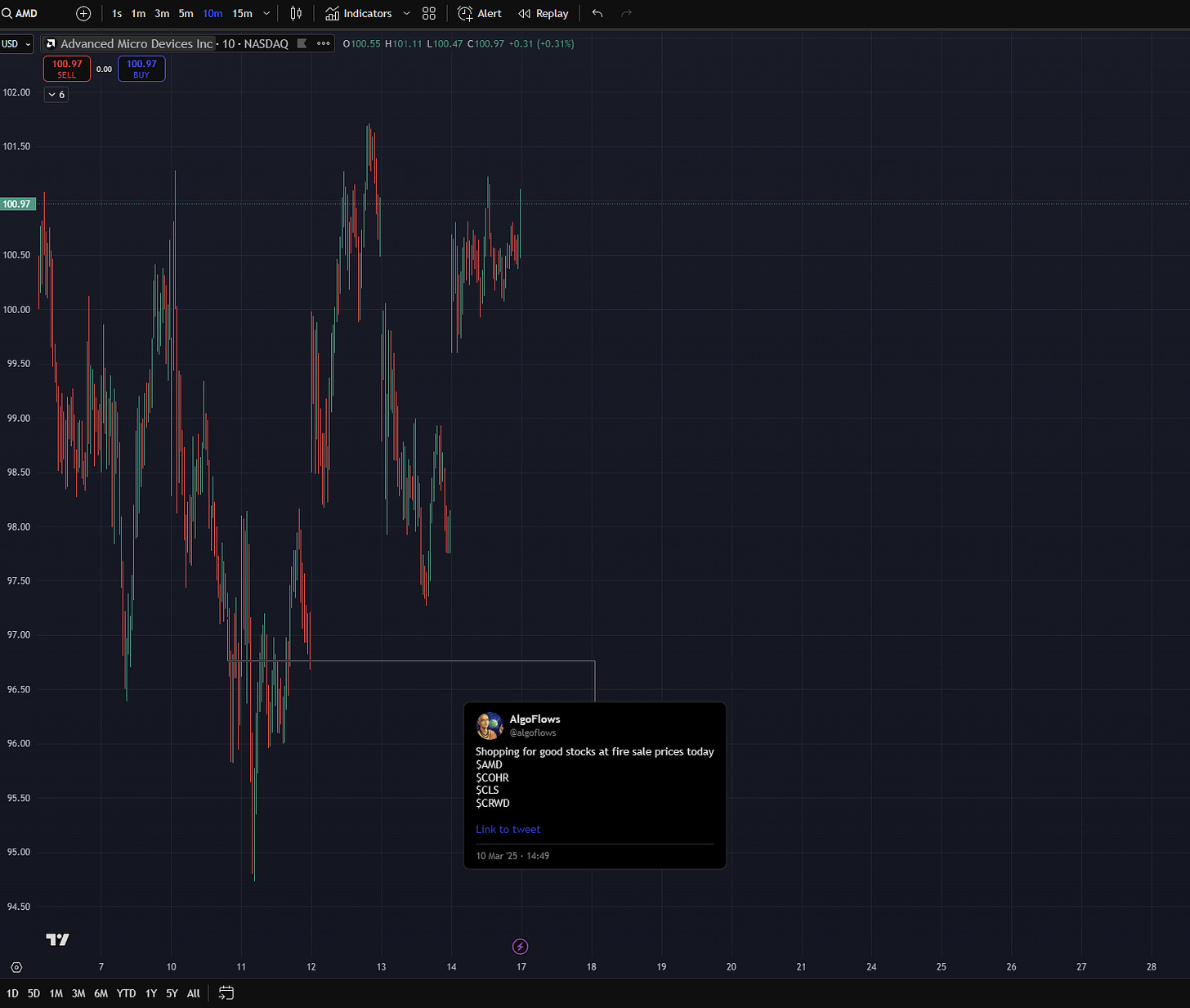Hello traders,
This past week was a rollecoaster of a week in the markets.
Recap of select trades from last week:
I spent better part of Monday knife-catching and eventually struck gold.
Buying the blood on NVDA 0.00%↑ COHR 0.00%↑ CRWD 0.00%↑ CLS 0.00%↑ and AMD 0.00%↑ paid off well.
Tuesday:
Wednesday:
Thursday:
Friday:
And a nice little EOD SPX lotto to cap off the week.
Interest Rates and Fed Policy
The Federal Open Market Committee has its next meeting scheduled for March 19, with markets currently assigning a very slim chance of a rate cut. The Fed's current rate stands at 4.25% to 4.5%, and market expectations suggest that rates will remain unchanged until at least June.
Fed Chair Jerome Powell has indicated that while rates are expected to move lower in 2025, the pace remains uncertain, stating "we do not need to be in a hurry to adjust our policy stance". The committee is balancing inflation concerns against potential risks to economic growth.
Inflation Data
The annual inflation rate in the US eased to 2.8% in February from 3% in January, coming in below market expectations of 2.9%. On a monthly basis, CPI rose by 0.2%, slowing from 0.5% in January. This moderation in inflation could provide the Fed with more flexibility later in the year.
Core inflation, which excludes food and energy, stood at 3.1% year-over-year in February, down from 3.3% in January, showing progress toward the Fed's 2% target.
The Mimetic Desire for Headlines
Markets now function as mimetic machines, desperately seeking headlines to justify their movements—a perfect illustration of Girardian mimetic theory. The crowd blindly copies what's around them without preferences or independent thought. This pathological dependency on U.S.-Canada policy headlines demonstrates not rationality but a herd seeking permission to move.
Tariff Implementation and Economic Impact
The Trump administration has implemented several significant tariff measures that are reshaping global trade flows and introducing new inflationary pressures. Effective March 7, 2025, the U.S. Customs and Border Protection (CBP) began collecting:
Additional 25% tariffs on goods that do not satisfy U.S.-Mexico-Canada Agreement (USMCA) rules of origin
A lower, additional 10% tariff on energy products imported from Canada that fall outside the USMCA preference
A lower, additional 10% tariff on potash imported from Canada and Mexico that falls outside the USMCA preference
Additional 20% on goods from China and Hong Kong (increased from 10% on March 4)
Furthermore, on March 12, 2025, the United States started applying a 25% tariff on imports of steel and aluminum products from all countries, including Canada, under section 232 of the US Trade Expansion Act of 1962. This has prompted retaliatory measures, with the Canadian government announcing that Canada will impose a 25% surtax on an additional $29.8 billion worth of US-origin goods starting March 13, 2025
I believe that the implementation of these tariffs marks a significant shift in U.S. trade policy, potentially having far-reaching implications for global supply chains and inflation. As I see it, companies are scrambling to adapt to these new realities, with many considering restructuring their supply chains or absorbing higher input costs.
Market participants are concerned that these tariffs could exacerbate inflationary pressures at a time when the Federal Reserve is attempting to bring inflation back to its 2% target. However, during a recent FOMC meeting, one Federal Reserve governor suggested the central bank might look through what could be a one-time increase in prices due to tariffs, saying: "The potential net effect of new economic policies also remains highly uncertain and will depend on the breadth, duration, reactions to, and, importantly, specifics of the measures adopted.”
Skin in the Game vs. Narrative Fallacies
The Trump admin has no skin in the game—they face no real downside from wrong decisions while harvesting the upside. This asymmetry of risk creates the worst kind of decision-making environment.
If Friday's rally unwinds, we might see Spooz retest September lows near 5400—but this linear prediction misses the point entirely. The real issue is the non-linearity of market responses to policy shocks. What appears as a gentle slope on your Bloomberg terminal masks fat-tailed risks that can explode exponentially.
Bear markets don't announce themselves with formal invitations. They arrive uninvited, disguised as "countertrend rallies" that sucker in the fragile and overleveraged. The most violent upward movements occur not in bull markets but during bear markets—creating maximum damage to both shorts and longs who mistime their entries and exits.
Navigating Uncertainty with Strategic Clarity
As markets approach a pivotal Federal Reserve decision amid evolving trade policies and mixed economic signals, maintaining strategic clarity while adjusting tactical positioning becomes increasingly important. The coming week offers potential for significant price discovery across asset classes, with Wednesday's FOMC decision representing a critical inflection point for near-term market direction.
Investors should approach this environment with a balanced perspective, recognizing both the legitimate concerns about policy uncertainty and the underlying resilience demonstrated by corporate fundamentals. Sector and factor selection take on particular importance in this environment, with potential for significant performance dispersion based on tariff exposures and interest rate sensitivities.
For traders focused on shorter time horizons, the week ahead offers potential opportunities across multiple asset classes, with the FOMC meeting creating a natural focal point for position management. Reduced exposure ahead of Wednesday's announcement, followed by tactical repositioning based on the market's reaction to the policy statement and press conference, represents a reasonable approach to managing event risk while maintaining participation in potential directional moves.
Longer-term investors should use recent volatility as an opportunity to reassess portfolio allocations relative to strategic objectives, potentially rebalancing toward areas that have experienced disproportionate weakness if underlying investment theses remain intact. While volatility may persist in the near term, maintaining discipline around long-term asset allocation targets typically proves rewarding during periods of market uncertainty.
The market's path forward will depend significantly on how the Federal Reserve balances its dual mandate of price stability and maximum employment amid evolving trade policies that introduce new variables into an already complex equation. By maintaining analytical discipline and emotional equilibrium, investors can navigate this challenging landscape more effectively and potentially identify compelling opportunities amid the uncertainty.
OKAY ALGO, I READ ALL THIS AND I’M NOW MORE CONFUSED THAN BEFORE
That is definitely understandable. You can sit on hands till FOMC Wednesday and then based on Chair Powell’s tone reposition yourself and watch out for tariff headlines I guess.
Moving on,
Weekly Levels:
Subscribers are urged to use the tradingview indicator to plot the levels.
Keep reading with a 7-day free trial
Subscribe to Algoflows Capital to keep reading this post and get 7 days of free access to the full post archives.















